 Hot Water
Hot Water
For the House
HOW DOES IT WORK?
The old style electric hot water systems are very inefficient using up to 25% of a households energy use and accounting for up to 23% of greenhouse emissions.
The new style storage tank systems use solar power, natural gas or a more energy efficient element to heat the water. Alternatively you can now have instantaneous water heaters that only heat the water as required and don’t require any storage.
Each type of system has its own unique features and a professional will be best to match the right style, type and size of water system to your household size, usage, budget, space and available energy sources.
HOW MUCH CAN I SAVE?
The possible savings will depend on the household usage patterns and other influencing factors. The Victorian Government completed a study on this subject and has estimated the following annual operating costs based on a 4 person household in Melbourne.
|
HOT WATER SYSTEM COMPARISON |
|||||
|---|---|---|---|---|---|
|
FUEL |
APPLIANCE |
WATER |
INSTALLATION |
PURCHASE PRICE* |
ANNUAL RUNNING COSTS** |
|
ELECTRICITY |
Off-peak (Y6) Off-peak (Y6) Peak rate (GD) Peak rate (GD) Heat pump (GD) |
Mains Constant Mains Reduced Mains |
Internal & external In roof space Internal at floor level Internal & external Internal & external |
$800-$1500 $600-$1200 $500-$800 $500-$1100 $2500-$3500 |
$225-$325pa $250-$350pa $775-$1100pa $650-$950pa $180-$260pa |
|
NATURAL GAS STORAGE |
Storage (5 star eff) Storage (2 star eff) Cont' flow (5 star) Cont' flow (2 star) |
Mains Mains Reduced Reduced |
Internal & external Internal & external Internal & external Internal & external |
$800-$1200 $700-$1000 $800-$2100 $600-$800 |
$175-$250pa $220-$300pa $175-$250pa $220-$300pa |
|
LPG*** STORAGE |
Storage (5 star eff) Storage (2 star eff) Cont' flow (5 star) Cont' flow (2 star) |
Mains Mains Reduced Reduced |
Internal & external Internal & external Internal & external Internal & external |
$800-$1200 $700-$1000 $800-$2100 $600-$800 |
$510-$710pa $650-$900pa $510-$710pa $650-$900pa |
|
SOLAR |
Solar/off peak stor' Solar/off peak stor' Solar/gas storage |
Constant Mains Mains |
Tank in roof space External tank External tank |
$2500-$4500 $2500-$4500 $3000-$5000 |
$80-$120pa $80-$120pa $175-$250pa |
* Excludes installation costs.
** Cost range is based on using 180–260 litres/day.180 litres/day is assumed for energy conscious users, 260 litres/day for high volume water users. Includes 7% pipe losses. Annual supply charges are not included. Costs are provided as a guide to running costs only. Actual costs will vary with usage, size of family and personal preferences.
*** Does not include cost of delivery and rental on gas bottles. LPG cost at 70¢ litre. LPG prices can fluctuate widely and vary geographically.
^ Cost range for solar hot water systems is based on 65% solar contribution.
NG Natural Gas
LPG Liquid Petroleum Gas
Source: Figures are based on information provided by gas supply retailers, the Australian Gas Association, electricity retailers and relevant manufacturers.
HOW MUCH DOES IT COST?
When considering cost you always need to mindful of the quality of the product and the quality and service and installation. The table above also includes the approximate system cost including installation and transport to site.
There is also Government Funded Incentive Scheme currently available in some states which can subsidise the cost of the system. Your sales and Installation Company will be the best people to advise your eligibility and potential rebate/discount/saving on your system cost. Click here to obtain 3 free no obligation quotes.
Alternatively, if you know which hot water system you would like to purchase, SaveEnergyQuote has partnered with Australia’s leading online retailers to bring you a selection of products that can help reduce your energy bill and save you money.
Click here to view Hot Water Systems
GOVERNMENT INCENTIVES
A standard electric hot water heater is the largest single source of greenhouse gas emissions from the average Australian home. It also accounts for almost 30% per cent of home energy use. The Australian Government is helping Australian households install environmentally friendly hot water systems. Rebates are available to eligible households when a solar or heat pump hot water system is installed. Different eligibility criteria exist depending on the rebate being applied for so we recommend obtaining an obligation free quote from a professional by clicking here.
When you are assessing your quote for an energy efficient hot water system be sure to consider any rebates or incentives as part of the quote.
MORE INFORMATION
Heat pump hot water systems
What is an air-sourced heat pump?
Air-sourced heat pumps absorb heat from air and transfer it to heat water. They run on electricity but are roughly three times more efficient than conventional electric water heaters so when used in the right environment they save energy, save money and reduce greenhouse gas emissions.
Heat pumps work on the same principle as your refrigerator but instead of pumping heat out of the fridge to keep it cool, they pump heat into water. Electricity is used to pump a refrigerant around the system which picks up heat from the air and transfers it to the water.
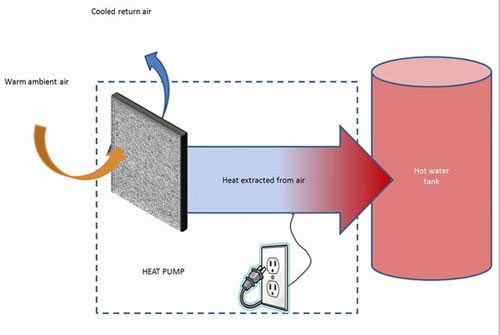
Diagram showing how heat pumps heat water
If a heat pump is right for you, choosing one will enable you to play your part in meeting the Australian government's goal of adopting smart, efficient technologies to maintain our quality of life at a lower cost to your budget and for the benefit of the environment.
How does it work?
An air-sourced heat pump works by absorbing heat from the outside air and transferring it to water in a tank. Like a water pump moves water uphill, a heat pump moves heat to where it is needed in the hot water tank. The secret to making a heat pump work is the use of a refrigerant that evaporates at low temperatures. There are several steps in the process:
-
Liquid refrigerant passes through an evaporator where it picks up heat from the air and becomes a gas.
-
The gas refrigerant is compressed in an electric compressor. Compressing the gas causes its temperature to increase so that it becomes hotter than the water in the tank.
-
The hot gas flows into a condenser where it passes its heat to the water.
-
The gas then flows into an expansion valve where its temperature drops and it returns to liquid form.
As long as the outside temperature is higher than the cold refrigerant the heat pump will absorb heat and be able to move it to the water. As the outside temperature decreases this becomes more difficult, which is why heat pumps don't work as well in places where temperatures are low.
Fresh air needs to flow across the evaporator to enable heat to be absorbed continuously. A fan is used to assist air flow and remove the cooled air. A ventilated space is necessary for the evaporator to extract heat effectively.
A heat pump uses electricity to drive the compressor and the fan instead of using electricity to heat the water directly. The heat pump is able to transfer heat energy from the surrounding air to the water which makes it highly efficient. How much heat is transferred depends on the ambient temperature.
For example, when air temperature is 15°C and the desired water temperature is 60°C, the heat transferred into the water is typically around 3 times as much as the electrical energy used. On a 30°C day, the heat energy transferred to the water is over 5 times the energy used by the system.
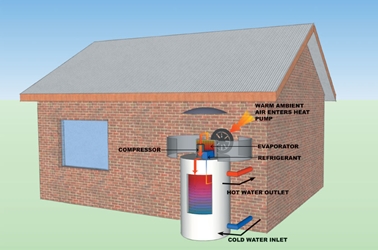
Heat pumps use warm air to heat water for your home
Electric Boost for Heat Pumps
Heat pumps may require an electric booster if operated in regions where it is cold. The electric boost turns on once the water temperature drops below a certain point.
Solar
What is a solar water heater?
A solar water heater uses energy from the sun to heat water for your home. Solar panels on your roof collect the sun's rays and heat the water that then flows to a storage tank ready for use.
A solar water heater is an effective way to make use of Australia's abundant sunshine. Depending on your location, the direction your solar panels face and the amount of water you use, a solar water heater can provide between 50 and 90 per cent of your hot water needs. Solar water heaters come with electric or gas boosters to provide the rest of your hot water needs.
There are many different types of solar water heaters available. It is important to select the type that is most suitable to your family size, climate, house type, roof characteristics, water quality, available space and aesthetic preferences.
If a solar water heater is right for you, it can save you energy, save you money and reduce your greenhouse gas emissions.
How does it work?
-
Solar water heaters use a tank to store water that has been heated by the sun.
-
Cold water flows from the tank to the solar collector usually positioned on your roof. In a split system like the one shown here, cold water is pumped up to the collector. In a thermosiphon system with the tank above the collectors on the roof, cold water flows naturally into the collector because it is heavier than hot water.
-
The solar collector is made of materials that absorb the sun's heat very efficiently. The cold water travels through the collector and the heat in the collector heats up the water which returns to the tank.
-
Hot water floats to the top of the tank and colder water is taken from the bottom and returned to the solar collector. When you need hot water it is taken from the top of the tank where the water is hottest.
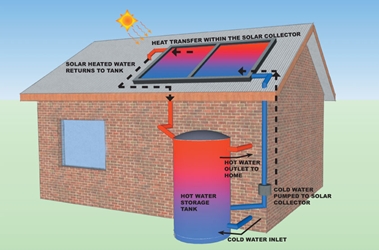
Diagram showing how solar hot water systems heat water
Gas water heaters
What is a gas water heater?
Gas water heaters burn either natural gas, delivered via a piped gas (reticulated) network, or bottled gas (LPG) to heat water. There are two main types of gas water heaters: storage and instantaneous.
Storage systems heat the water stored in a tank.
Instantaneous heaters, sometimes called continuous flow, don't have a storage tank and only heat the water when it is required.
Using gas instead of electricity to heat your water can help to reduce your greenhouse gas emissions and may lower your water heating costs.
Types of gas water heaters
Storage
Gas storage systems are all very similar in the way that they work. The main variations are in the tank material, the burner and flue technology and whether they are designed for indoor or outdoor installation.
The most common tank material is enamelled steel but stainless steel is also used. Stainless steel is more expensive but the tank will usually last longer.
Some units use a special flue system to recirculate the hot flue gases around the outside of the tank to increase heat transfer into the water and increase their efficiency.
Units installed indoors need a flue to exhaust the combustion gases outdoors.
Instantaneous
There are two different types of instantaneous heaters. One type is very simple and has a fixed burner flame so the water temperature will vary with the rate of water flow from the tap. They usually have a pilot flame or battery ignition and do not need an electricity supply. They generally have limited flow rates of up to about 16 litres per minute and are not suitable for houses with more than one bathroom, however, they are usually cheaper to buy and install.
The other type of instantaneous heater has electronic controls that vary the flame size to deliver water at a constant preset temperature and fans that improve the combustion efficiency. They can be fitted with controls to allow you to set the water temperature you want. This means you can preset the water temperature so you don't need to mix the hot water with cold water to ensure a safe bathing temperature.
Electronic units can be preset to deliver hot water at no more than 50°C as required by plumbing regulations for bathrooms.
There are also very efficient condensing instantaneous units available. These use the heat from the exhaust gas to pre-heat the cold water before it enters the heat exchanger thereby reducing energy use. Although rated at 6 stars, as this is currently the maximum rating, they use less energy than non-condensing units so look for the MJ per year energy consumption figure on the label as well as the star rating to compare products.
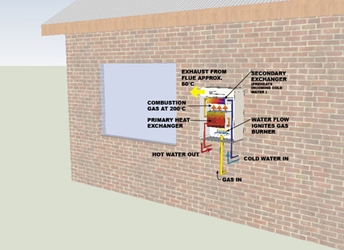
High-efficiency gas instantaneous water heater with condensing technology
Some of the non-electronic instantaneous models may not be suitable for use with water efficient 3 star showerheads as the hot water flow rate will be too low. Check with your plumber or water heater supplier or manufacturer.
How do they work?
Storage heaters
Storage heaters use a gas burner located underneath the water storage tank to heat the water. They usually have a continuously burning pilot flame that ignites the main burner when it is needed. Heat is then transferred from the gas burner through the bottom of the cylinder. Some heat also flows from the hot flue pipe into the water. When hot water is drawn off at the top of the tank, cold water enters the tank at the bottom. Most units have an adjustable thermostat to set the water temperature. When the temperature at the bottom of the tank drops below the level set on the thermostat the pilot flame ignites the main burner so the water is kept constantly hot. The energy from the pilot flame is not wasted as it helps to heat the water in the tank.
Storage systems should be set to at least 60°C to kill any pathogens and avoid legionella, so you might like to consider a temperature control valve to limit the bathroom water temperature. The hot water from the water heater needs to be mixed with cold water to ensure a safe bathing temperature.
Storage systems come in a range of tank sizes from about 90 to 300 litres.
Storage heaters lose heat through the walls of the tank (called standing heat loss), so they need to burn gas regularly to keep the water at the desired temperature. These losses can be a significant proportion of your hot water energy use and your gas bill. All tanks have some insulation to reduce standing heat losses but a better insulated tank will have lower storage losses, so look for one with a high energy star rating.
Gas water heaters (except gas boosted solar) have an energy star label to tell you how efficient they are. This is similar to the energy label on electrical appliances. The more stars the better. Once you have decided on the type and size of water heater you need, use the label to select the most efficient model by choosing one with the highest number of stars and the lowest energy consumption. More stars mean lower running costs for you and less greenhouse gas emissions.
Storage systems have a range of efficiencies from about 2 to 5 stars. The Australian Government plans to introduce a minimum performance standard for gas water heaters that will require them to be at least 4 stars.

Gas storage water heater
Instantaneous heaters
In an instantaneous system, the water is heated by a gas burner as it flows through a coiled pipe called a heat exchanger. The gas burner starts when a hot water tap is turned on. It only heats the amount of water that is required instead of continuously heating a full tank. As they don't store any hot water they do not have heat losses from a tank and so can have energy and cost savings.
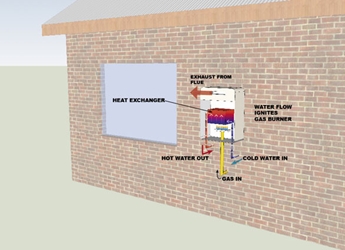
Standard gas instantaneous water heater
To allow enough time for heating, the water is slowed down as it flows through the heat exchanger. This means that instantaneous units supply hot water at a lower pressure than storage systems. They can typically deliver hot water at flow rates of between 10 to 30 litres per minute depending on the model. Some instantaneous systems have a pilot flame to light the main burner and some have electronic ignition that uses a spark to light the gas - the same as those used on gas stoves. Instantaneous units with a pilot light are less efficient than those with electronic ignition because, unlike in a storage system, the pilot light energy is wasted. Look for models with electronic ignition.
Instantaneous units have an efficiency rating in the range of 4 to 6 stars. The energy label assumes that you use 200 litres of hot water per day, which is about what a typical 4 or 5 person household would use. If you use that much hot water, then a 5 star storage system and a 5 star instantaneous system will use about the same amount of energy each year. However, if you use less hot water, an instantaneous system might use less energy as it has no storage losses.
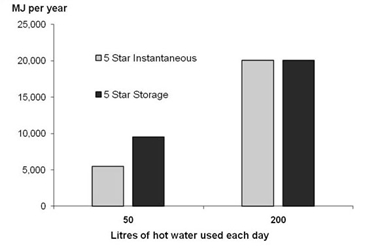
Comparative energy consumption of gas water heaters



